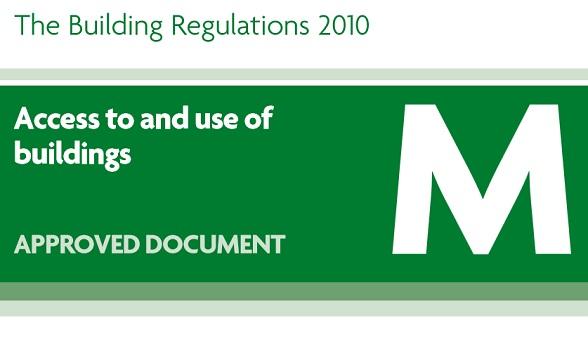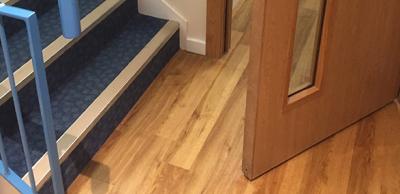Building Regulations Approved Document Part M in a Nutshell
Changes in 2015 to the Building Regulations Approved Document Part M, which contains guidance on access, introduced some new standards for new-build dwellings. The base standard is fairly similar to the old Part M; M4(2) is a higher standard that designs new dwellings so that they're more easily accessed and adapted should the need arise in future; M4(3) is fully wheelchair adaptable or accessible. The local planning authority will determine what standard of accessibility is required for each development as a condition of the planning permission.
If a local planning authority introduces one of these optional standards, you, as the developer, must inform building control that you’ll be meeting the higher level of requirements.
To help you plan and budget, here’s a simple roundup of the main differences between M4(1) (the basic standard) and M4(2) (the intermediate standard):
External differences
- All external doors must have a level threshold - the lower standard is just one door
- Approach routes must have a minimum clear width of 900mm or 750mm where there are obstructions, the gradient should be between 1:20 and 1:12
- Every gateway must have an 850mm clear opening, with a 300mm nib on the leading edge to allow users to reach the handle
- Parking spaces within the private curtilage of the dwelling (but not a car port or garage) must include at least one standard parking bay that can be widened at a later date to 3.3m
- Every principal entrance must have a cover(canopy, overhang or recess for example) with minimum width of 1200mm and depth of 900mm for communal entrances or a width of 900mm and depth of 600mm for private entrances. This can’t be a porch
- External doors must have an openable width of 850mm and have a 300mm nib on the leading edge (see diagram 2.2 ADM)
Internal differences
- Stairs must be a minimum width of 850mm to allow the future installation of a stair lift
- At least one bedroom must have a 750mm clear access zone from the foot of the bed and on both sides. Every other double bedroom will need a clear access zone on one side and the foot of the bed. Plans of furniture layouts in this case will need to be provided to show compliance (See diagram 2.4 ADM)
- All walls, ducts and boxings to the WC/cloakroom, bathroom and shower room should be strong enough to support grab rails, seats and other adaptations that could impose a load of up to 1.5kN/m2
- A bathroom must be located on every floor that has a bedroom
- Ground floor WC must have a hidden drainage connection and be large enough to accommodate a shower (see diagram 2.6 ADM)
- Consumer units must be mounted at a height between 1350mm and 1450mm above floor level
- Handles for windows, unless on a remote opening system, must be located between 450mm and 1400mm above floor level
There are lots of other new details to think about, so talk to your local authority building control team as early as possible to ensure your design will comply.
Find your local building control team
Further reading
Building Regulations Approved Document M (Dwellings)
Please Note: Every care was taken to ensure the information was correct at the time of publication. Any written guidance provided does not replace the user’s professional judgement. It is the responsibility of the dutyholder or person carrying out the work to ensure compliance with relevant building regulations or applicable technical standards.
This article was checked and updated on 18th March 2022
Sign up to the building bulletin newsletter
Over 48,000 construction professionals have already signed up for the LABC Building Bulletin.
Join them and receive useful tips, practical technical information and industry news by email once every 6 weeks.
Subscribe to the Building Bulletin




Comments
Maximum handle height
Submitted 2 years 9 months ago
LABC response
Submitted 2 years 9 months ago
Thank you for your query. The only guidance given in Approved Document M is where the domestic house is being constructed as a Category 3 wheelchair accessible/adaptable home. Otherwise, no internal door handle height is specified. Where the home is required to be wheelchair accessible or adaptable, the door handles should be easy to grip and use and be fitted between 850mm and 1000mm above floor level.
Best,
LABC team
M4(3) - 1500x1500 outside flat entrance
Submitted 2 years 5 months ago
LABC response
Submitted 2 years 4 months ago
Thank you for your comment, the guidance in Approved document M4(3)refers to the relevant dimensions in diagram 3.3 with a clear 1500mm x 1500mm external landing and a minimum 1500mm turning circle inside the entrance area in front of the door when closed. Your LABC team, where the project is based would be able to advise on drawings and proposals for the building.
Best,
LABC team
M4(2) Maisonettes
Submitted 2 years 4 months ago
LABC response
Submitted 2 years 4 months ago
Thank you for your enquiry.
LABC is a membership organisation, providing advice and support to its member local authorities around England and Wales. As a result, LABC cannot comment on the application and enforcement of the Building Regulations on individual cases, as this is a matter for the local council – being the enforcing authority for building regulations.
The requirement for ‘category 2 - accessible and adaptable dwellings’ (i.e., M4(2)) is:
(1) Reasonable provision must be made for people to—
(a) gain access to; and
(b) use, the dwelling and its facilities.
(2) The provision made must be sufficient to—
(a) meet the needs of occupants with differing needs, including some older or disabled people; and
(b) to allow adaptation of the dwelling to meet the changing needs of occupants over time.
The guidance related to the above is contained within ‘Approved Document M Volume 1’ which can be viewed at https://assets.publishing.service.gov.uk/government/uploads/system/uploads/attachment_data/file/540330/BR_PDF_AD_M1_2015_with_2016_amendments_V3.pdf. We are unable to comment any further on this occasion as it is unclear which part of the building your query relates to – such as access provisions from car parking and drop-off spaces, or access into communal and private entrances, or access to circulation areas within the dwelling and the like. Therefore, we would recommend you consult with your agent on the general design and liaise with your Local Authority Building Control Department if you have a specific query.
Best wishes,
LABC Team
Level Access
Submitted 2 years 3 months ago
Part M states "2.20 - The principal private entrance, or the alternative private entrance where step-free access cannot be achieved to the principal private entrance, should comply with all of the following...."
"a. There is a level external landing with a minimum width and depth of 1200mm"
This reads that at least one entrance must have a level external landing however the other access can be stepped as long as it complies with d. to i. of paragraph 2.20. d. to i. does not refer to level access.
I believe you are referring to an "Accessible Threshold" as per 2.20 h. which is not the same as a level threshold.
LABC response
Submitted 2 years 3 months ago
Thank you for your comment.
The article looks to compare the standards and guidance in the M4 (1) category for visitable dwellings, when compared with the M4(2) option. The comments you make are valid to the M4 (2) category for accessible and adaptable dwellings which have been noted.
Best,
LABC
External steps
Submitted 1 year 9 months ago
LABC Response
Submitted 1 year 8 months ago
LABC is unable to comment on specific projects as we are a member organisation representing the public sector building control profession in England and Wales. If the building is one to which a building regulation application applies, then you should discuss the matter with the local LABC team.
Best,
LABC Team
Ychwanegu sylw newydd